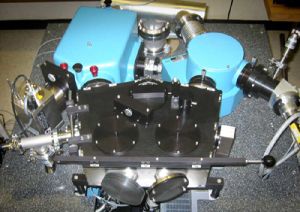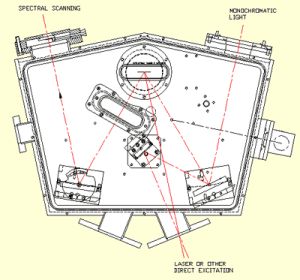
Spectral Emission, Excitation and Luminescence Measurement
- 120 to 2600nm wavelength range
- 10 sample positions
- Aux input for laser and x-ray excitation
- Optional - Lifetime / Persistence measurement capability
- Optional - Cryogenic / heated sample mounts
The McPherson Vacuum UV Spectrophotometer is designed for Transmission, Reflection and Emission measurements across a broad wavelength range. The system has a usable wavelength range of 115nm to 930nm - this can be expanded deeper into the Extreme UV or into the IR with addition of sources and detectors. The interchangeable sample holder(s) accept five 25mm diameter samples in the emission, transmission and reflectance positions. Samples can be indexed under vacuum. The optical, electrical and pumping systems are built into the supporting table for easy transport and set up. The computer sits on a separate table. All cables and lines are quick disconnect type and are labeled for easy set up.
Excitation and Emission The excitation source is a CW Deuterium lamp with Magnesium Fluoride (MgF2) window. The lamp window seals the instrument vacuum vessel and all emitted wavelengths from about 120nm to 380nm can be used for excitation. The discrete excitation wavelength is selected by an optimized Vacuum UV McPherson Model 234/302 high throughput 200mm scanning monochromator. Monochromatic excitation energy is collected and focused to the sample position. Alternate means of excitation are possible by use of accessory ports in the sample chamber, Excimer laser or x-ray sources for example.
Vacuum UV Spectrophotometer PDF Data Sheet
Specifications
Vacuum UV Optical Characterization System
| Excitation Wavelength(s) | < 1nm FWHM discrete bands selectable from 120 to 380nm
Vacuum monochromator Model 234/302
Filters and Excimer sources - optional |
| Emission Wavelength(s) | < 1nm FWHM discrete bands measured from 120 to 900nm
PMT used for lifetime and scanning
CCD for Color and survey work - optional |
| Sample Size | 5 ambient temperature 25mm diameter samples
vertical mounting |
| Sample Environment | Ambient / Room temperature
Cryogenically cooled (single sample) - optional
Heated (to 400deg C) (single sample) - optional |

Mounting Samples Optics in the sample chamber focus the energy from the excitation monochromator. The focused energy is transmitted through or reflected off the samples within the chamber and refocused into the emission monochromator. The sample chamber has two sample holder positions, a transmission position and a reflectance/emission position. The transmission position places the samples normal to the excitation beam, a first surface mirror must be placed in the reflectance/emission position during transmission measurements. The reflectance/emission sample holder position places the samples in the beam focus and allows the samples to be rotated with respect to the excitation beam angle of incidence. This angle adjustment can be used to exclude the specular component when measuring fluorescent or diffuse samples. The angle adjustment can also be used to optimize the signal when measuring glossy samples such as mirrors or wafers. Emission mode signal collection optics can be tuned to optimize light collection and focus at the emission monochromators entrance slit while under vacuum.
Select Publications
Abstract: Vacuum ultraviolet reflectivity measurements of three thin-film electroluminescent phosphors, zinc sulfide ~ZnS!, strontium sulfide ~SrS!, and strontium-calcium thiogallate (Sr0.45Ca0.55Ga2S4), are reported using thin-film samples. Measured ZnS reflectivity peak positions are in agreement with values previously reported in the literature. SrS room temperature reflectivity measurements are found to be consistent with previously reported low temperature measurements. Reflectivity measurements of Sr0.45Ca0.55Ga2S4 are reported for the first time; the reflectivity spectrum is found to rise monotonically above the band gap and to exhibit almost no structure, except for a small shoulder at ;6.8 eV and a single, broad peak at ;8.5 eV. The unusual nature of the Sr0.45Ca0.55Ga2S4 reflectivity spectrum is attributed to positional disorder in the stoichiometric
thiogallate film.
K. Lite, R. L. Thuemler, T. K. Plant, and J. F. Wager, D. C. Morton, S. S. Sun, R. H. Mauch
Abstract: Visible-light and infrared-light persistent phosphors are extensively studied and are being used as self-sustained glowing tags in darkness. In contrast, persistent phosphors for higher-energy, solar-blind ultraviolet-C wavelengths (200–280 nm) are lacking. Also, persistent tags working in bright environments are not available. Here we report five types of Pr3+-doped silicates (melilite, cyclosilicate, silicate garnet, oxyorthosilicate, and orthosilicate) ultraviolet-C persistent phosphors that can act as self-sustained glowing tags in bright environments. These ultraviolet-C persistent phosphors can be effectively charged by a standard 254 nm lamp and emit intense, long-lasting afterglow at 265–270 nm, which can be clearly monitored and imaged by a corona camera in daylight and room light. Besides thermal-stimulation, in bright environments, photo-stimulation also contributes to the afterglow emission and its contribution can be dominant when ambient light is strong. This study expands persistent luminescence research to the ultraviolet-C wavelengths and brings persistent luminescence applications to light.
Xianli Wang, Yafei Chen, Feng Liu, Zhengwei Pan

